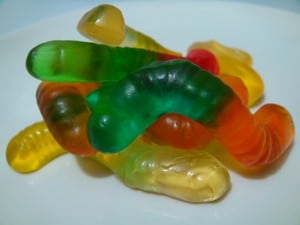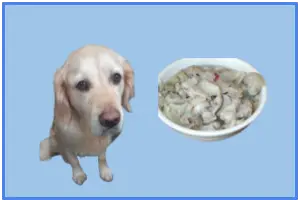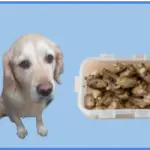Today, I want to talk about whether you can or should feed your dog gummy worms!
And to tell you the truth, what fascinates me more than deciding whether we should be feeding our dog this form is candy, is to work out why this is happening.
And I wonder if it is a consequence of Lockdown.
Most of us are spending more time at home than we normally do, which is good news for our dogs.
We are also eating more comfort food and sweet things to keep our spirits up.
And I just wonder if we are sharing some of these human treats with our dogs?
I don’t know the answer to that one but in the next section I will talk about whether dogs can eat gummy worms…
My dog ate gummy worms! What should I do?
I think that the great news is that there is nothing in most brands of gummy worms that are toxic or poisonous to your dog.
There might be a lethal exception found in sugar free varieties- I discuss this in more detail below.
What will happen to a dog that has eaten gummy worms depends on how many he has eaten compared to how large he is.
Dogs that have just eaten a few gummy worms won’t suffer any side effects and may in fact think that they have just won the lottery.
But a dog that has eaten a whole bag of gummy worms will be feeling very poorly indeed.
They might vomit and they will have a bad dose or diarrhea for a day or so.
And so, in this situation, just get the rubber gloves ready!
But if your dog shows any signs of unusual behaviour such as lethargy or if the diarrhea continues for longer than a day or so, phone your vet.
What are gummy worms?
Gummy worms are just one shape of gummy or jelly sweets- which is the name given to a sort of sweet which is made using gelatin- that Jelly Baby texture.
There is a simply enormous range of different colours and shapes from any number of different manufacturers for a sweet or candy that is essentially identical.
Other popular selling shapes include gummy bears, gummy fruit, gummy burger, gummy suckers and gummy snakes.
Smooth or sugar coated, sweet or sour, the choice is yours.
And they are even used in vitamins!
As if your head wasn’t spinning from all the options, it even seems as if size doesn’t matter.
Gigantic gummy worms are available.
Oh, you mean Gummy Snakes?
No. I mean The World’s Largest Gummy Worms.
All three feet and four thousands calories of them.
What are the main ingredients of gummy worms?
Joking aside, if your dog did eat a supersized gummy worm, it is a trip to the vets.
But what ingredients are these very more-ish and addictive sweets made from?
Of course, the exact recipe is a top secret.
But here is the list of ingredients and remember the most used ingredients always come first.
And the following ingredients are from two of the biggest manufacturers of gummy worms- Black Forest and Haribo.
So here are the ingredients:
| Black Forest | Haribo |
| Corn syrup | Glucose syrup |
| Sugar | Sugar |
| Gelatine | Gelatine |
| Modified corn starch | Dextrose acid |
| Concentrated apple juice | Citric acid |
| Sodium nitrate | Flavouring |
| Natural and artificial flavours | Fruit and plant concentrates |
| Coconut oil |
Both brands of gummy worms are made almost entirely from one form of sugar or another.
The biggest ingredient is corn or glucose syrup.
These are two different names for an identical product.
This syrup is made from mixing cornstarch with several different forms of sugar.
And the next biggest ingredient is sugar.
Quickly moving on, the third ingredient is gelatine.
Gelatine is a substance that is made from boiling animal bones- although now there are vegetarian alternatives.
It provides gummy worms (and jelly) with that soft, jelly- like texture.
From here, Haribo uses dextrose and citric acid to make their “gummies”.
Dextrose acid is another form of sugar and citric acid is a flavouring that tastes like lemons.
Black Forest gummy worms have corn starch in them, which isn’t strictly a sugar but a carbohydrate.
And it can raise blood sugar levels.
Is sugar poisonous to dogs?
So, coming out of all of that, I guess a key question is how does sugar affect dogs?
The great news is that sugar isn’t poisonous for your dogs but it is not an ingredient that they need.
There are essentially five possible side effects for a dog that has eaten too much sugar.
And they are: diarrhea, cavities, hyperactivity, obesity and diabetes.
Sugar can cause diarrhea because of the way that interferes with bacteria in their stomachs
Bacteria use sugar in a dog’s mouth to make acid which then attacks the surface of the tooth.
Sugar causes obesity when the body is forced to store it as fat.
The danger of going sugar free
Obviously sugar has had a very bad press in recent years and so in response the food industry has tried to come up with alternative products that are low in sugar or even sugar.
And when you look at the five side effects that your dog might suffer from eating too much sugar, the cynical amongst us might be saying “better late than never.”
However good sugar free foods might be for us, they can be lethal to our dogs.
Or rather one sugar free ingredient can be, which is called xylitol.
Now I have done a quick scan on Amazon, looking for sugar free gummy worms (and sugar free gummies in general) and the good news is that I can’t see any mention of it.
But that doesn’t mean that it hasn’t been added to any packet of gummy worms and so please check carefully.
Why is xylitol used?
And this ingredient is called xylitol.
Xylitol is used because it is as sweet as processed sugar but it doesn’t contain as many calories (about 40% less) and it is much kinder to teeth than traditional sugar.
It is used in a wide range of products, such as chewing gum, mints, toothpaste, dietary supplements and drugs.
Xylitol can kill your dog
Even quite small doses of xylitol are poisonous to dogs because of the effect it has on their blood sugar levels.
When a dog ingests xylitol, it (wrongly) triggers the pancreas into releasing a huge amount of insulin into a dog’s blood.
This in turn causes their blood sugar levels to crash and could potentially lead to death.
How much xylitol can kill a dog?
This all depends on the size of your dog and the amount of xylitol that they have ingested.
And therein lies the rub.
Xylitol isn’t used in consistent amounts, even in the same products.
Dog friendly alternatives to gummy worms?
So after all of that, I think it seems logical to start looking at alternatives to gummy worms.
And I’m not going to even include a section in this article about the best candy for my dog because there is no such thing!
Dogs shouldn’t be consuming candy- period.
There is a vast selection of readily available alternatives to feeding dogs candy, even if you don’t include dog biscuits and other commercial dog treats.
What I am thinking of is a few “sweet” vegetables both of which can be given raw to your dog.
Not only are they naturally sweet but they also have a natural crunch which should prove more popular with your dog than the soft and chewy texture of a gummy worm!
The vegetables I’m thinking of are: celery, sweet potato or carrot.
And you can think outside of the box a little- why not try to give your dogs frozen carrots?
Most of us have these items to hand in our kitchen cupboards or in the fridge on a regular basis which makes them even more of an ideal choice.
In the next section I want to move on to a slightly stickier issue., which is why would our dogs be fed gummy worms in the first place?
Why might dogs be fed gummy worms?
Yes, now this is a strange one I must admit.
But I can see how it might be happening in a couple of situations.
And the first context involves toddlers.
My two and a half year old grandson sometimes eats as he is walking round the house, moving from one toy or activity to the next.
And this isn’t an ideal situation because in a perfect world we would want him sitting at the table to eat.
But, we don’t live in a perfect world, do we?!
The problem with toddlers wandering around and eating is that the food is at the same height as a dog.
Now my grandson doesn’t eat gummy sweets (yet.)
But I can see how in a house where a toddler and a dog live together that a dog might be eating the odd gummy worm or two.
And the second context involves older children or even adults feeling guilty.
As well as having a dog that stalks my grandson, I have a 14 year old Golden Retriever who can be very demanding and very vocal about it.
The trigger points are mid afternoon before she has been fed her dinner or early in the evening before she settles down to sleep.
Instead of just ignoring her and making her wait for her dinner, sometimes her demands are so insistent and I give in and give her a biscuit.
After all, I’m trying to get some work done!
I might feed her a biscuit but other people or children in the same situation might throw her a sweet or candy just to “shut her up”.
Most of us are in lockdown of one form or another.
Unable to go into the office or school, we are at home more and we are spending more time with our dogs- which they love.
The trouble is that this makes it harder to say “no” to them and they can easily become more spoiled!
How to stop my dog from eating gummy worms?
I think in most situations, the way to stop your dog from eating gummy worms is to stop everyone in your house from feeding them to your dog.
I mean, as I have explained above, most of the time that dogs are eating gummy candy it is because they are being fed to them as treats.
And if this is the case and you need to feed your dog a treat, try feeding one of the vegetables I suggested above.
I think that there is an exception to this.
The bag of gummies that are accidentally left on the kitchen counter or on the living room floor in a moment of complete forgetfulness.
I do think it is very hard to prevent those types of one off events, where despite our best efforts, we just forget because we were so busy.
I don’t think there is an organisational trick to prevent these mistakes happening.
Saying that all kitchen surfaces must be left clear before you leave the house just won’t cut it will it?







